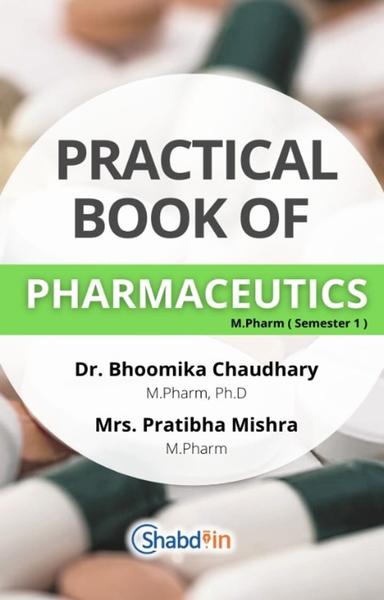AIM: Formulation and evaluation of osmotically controlled DDS.
REQUIREMENT: Beaker, stirrer, compression machine (CIP)
Reference:M Sowjnya, P Shrinivasa Babu Review article Osmotic Drug Delivery System June 2017page no 1 to 10.
Theory:
OSMOTIC PRESSURE: Osmotic pressure of a solution is the external pressure that must be applied to the solution in order to prevent it being diluted by the entry of solvent via a process known as Osmosis.Osmolality: is the number of osmoles per Kg of water.Osmolality: is the number of osmoles per litre of solution.Iso-osmotic solution is one where two solution are separated by a perfect semi permeable membrane (SPM is membrane which is permeable only to solvent molecule and no net movement of solute occur across the membrane.In Isotonic solution biological membrane do not always function as perfect SPM and some solute molecule as well as water are able to pass through them.ADVANTAGE OF OSMOTIC DDS:
The delivery rate of zero-order is achievable with osmotic systems.Delivery may be delayed or pulsed, if desired.Higher release rates are possible with osmotic systems compared with conventional diffusion-controlled drug delivery systemsThe release rate of osmotic systems is highly predictable and can be programmed by modulating the release control parameters.For oral osmotic systems, drug release is independent of gastric pH and hydrodynamic conditions.The release from osmotic systems is minimally affected by the presence of food in gastrointestinal tract.A high degree of in vivo- in vitro correlation (IVIVC) is obtained in osmotic systems.Disadvantages of osmotic DDS
Special equipment is required for making an orifice in the system.Residence time of the system in the body varies with the gastric motility and food intake.It may cause irritation or ulcer due to release of saturated solution of drug.MECHANISM OF OSMOSIS
Core contain water soluble osmotically active agent and blended with water soluble or insoluble drug, additives and coating has been carried out which functions as semi permeable membrane. Since barrier is only permeable to water, initial penetration of water dissolves the critical part of the core, resulting in development of an osmotic pressure difference across the membrane.
The device delivers a saturated volume equal to the volume of water uptake through the membrane. Initial lag time (per hour) during which delivery rate increases to its maximum value, drug release is zero order, until all solid material is dissolved. The relation between Osmotic pressure (П) and the concentration of nonelectrolyte is given for dilute solution which may be assumed to exhibit ideal behaviour by the Van’t Hoff equation,
ПV = n 2 RT
Where,
V = is the volume of solution.
n 2 = is number of moles of solute.
T = thermodynamic temperature
R = is the gas constant.
FORM ULATION OF OSMOTIC DDS:
DRUG: Drug itself may act as an osmogen and shows good aqueous solubility (e.g., potassium chloride pumps). But if the drug does not possess an osmogenic property, osmogenic salt and other sugars can be incorporated in the formulation.
SEMIPERMEABLE MEMBRANE: Semipermeable membrane must possess certain performance criteria:
1) It must have sufficient wet strength and water permeability.
2) It should be selectively permeable to water and biocompatible. Some other polymers such as agar
Acetate, amylose triacetate, betaglucan acetate, poly (vinylmethyl) ether copolymers, poly (orthoesters), poly acetals, poly (glycolic acid) and poly (lactic acid) derivatives.
The unique feature of Semipermeable membrane utilized for an osmotic pump is that it permits only the passage of water into the unit, thereby effectively isolating the dissolution process from the gut environment.
OSMOGEN / OSMAGENT / OSMOTIC DRIVING AGENT: Osmotic agents are classified as,
Inorganic water soluble osmogen: Magnesium sulphate, Sodium chloride, Sodium sulphate, Potassium chloride, Sodium bicarbonate, etc.
Organic polymeric osmogens: Na CMC, HPMC, HEMC, etc. Organic water soluble osmogen: Sorbitol, Mannitol, etc.
HYDROPHILIC AND HYDROBHOBIC POLYMERS: These polymers are used in the formulation development of osmotic systems containing matrix core. The selection of polymer is based on the solubility of drug as well as the amount and rate of drug to be released from the pump. The highly water soluble compounds can be co-entrapped in hydrophobic matrices and moderately water soluble compounds can be co-entrapped in hydrophilic matrices to obtain more controlled release.
Examples of hydrophilic polymers are hydroxy ethyl cellulose, carboxy methyl cellulose, hydroxyl propyl methyl cellulose, etc. Examples of hydrophobic polymers are ethyl cellulose, wax materials, etc.
WICKING AGENTS: It is defined as a material with the ability to draw water into the porous network of a delivery device. The function of the wicking agent is to draw water to surfaces inside the core of the tablet, thereby creating channels or a network of increased surface area. Examples are colloidon silicon dioxide, kaolin, titanium dioxide, alumina, niacinamide, sodium lauryl sulphate (SLS), low molecular weight polyvinyl pyrrolidone (PVP), bentonite, magnesium aluminium silicate, polyester and polyethylene, etc.
SOLUBILIZING AGENTS: Non swell able solubilizing agents are classified into three groups
• Agents that inhibits crystal formation of the drugs or otherwise act by complexation of drug (e.g., PVP, PEG, and Cyclodextrine)
• A high HLB micelle forming surfactant, particularly anionic surfactants (e.g., Tween 20, 60, 80, poly oxy ethylene or polyethylene containing surfactants and other long chain anionic surfactants such as SLS).
• Citrate esters and their combinations with anionic surfactants (e.g., alkyl esters particularly triethyl citrate).
SURFACTANTS: They are added to wall forming agents. They act by regulating the surface energy of materials to improve their blending in to the composite and maintain their integrity in the environment of use during the drug release period. Examples: polyoxyethylenated glyceryl recinoleate, polyoxyethylenated castor oil having ethylene oxide, glyceryl laurates, etc.
COATING SOLVENTS: Solvents suitable for making polymeric solution that is used for manufacturing the wall of the osmotic device include inert inorganic and organic solvents. Examples: methylene chloride, acetone, methanol, ethanol, isopropyl alcohol, ethyl acetate, cyclohexane, etc.
PLASTICIZERS: Permeability of membranes can be increased by adding plasticizer, which increases the water diffusion coefficient.
Examples: dialkyl phthalates, trioctyl phosphates, alkyl adipates, triethyl citrate and other citrates, propionates, glycolates, glycerolates, myristates, benzoates, sulphonamides and halogenated phenyls.
FLUX REGULATORS: Flux regulating agents or flux enhancing agent or flux decreasing agent are added to the wall forming material; it assist in regulating the fluid permeability through membrane. Poly hydric alcohols such as poly alkylene glycols and low molecular weight glycols such as poly propylene, poly butylene and poly amylene,etc. can be added as flux regulators.
PORE FORMING AGENTS: These agents are particularly used in the pumps developed for poorly water soluble drug and in the development of controlled porosity or multiparticulate osmotic pumps. The pore formers can be inorganic or organic and solid or liquid in nature.
Like,
• Alkaline metal salts such as sodium chloride, sodium bromide, potassium chloride, etc.
• Alkaline earth metals such as calcium chloride and calcium nitrate
• Carbohydrates such as glucose, fructose, mannose, etc.
Different kinetic orders
Procedure
Method of Preparation of Core Tablets
Mannitol was used as osmogent in this formulation because other osmogents like sodium chloride, potassium chloride, magnesium sulphate, etc. are inorganic water soluble osmogent. Metoprolol tartrate is antihypertensive drug. In hypertension inorganic salts are restricted because this salt increases hypertension. Also, mannitol is directly compressible and having good osmogenic property. So, mannitol was used as osmogent.
The batches F1 to F3 were prepared by direct compression technique. The formulation ingredient quantity was selected as per trial and error method. This trial and error method was also supported by extensive literature review for nearby optimize quantity of each ingredients in this study. The ingredients were individually passed through 40# and mixed for 15 minute in mortar and pestle as per the formula shown in table 1. The blend was again passed through
EVALUATION:
A) WEIGHT VARIATION
B) HARDNESS
C) FRIABILITY
D) THICKNESS
E) DISSOLUTION
F) PORE DIAMETER
G) COATING THICKNESS
IN VITRO EVALUATION: The in vitro release of drugs from oral osmotic systems has been evaluated by the conventional USP paddle and basket type apparatus. The dissolution medium is generally distilled water as well as simulated gastric fluid (for first 2-4 h) and intestinal fluids (for subsequent hours) have been used. The standard specifications, which are followed for the oral controlled drug delivery systems are equivalently applicable for oral osmotic pumps.
IN VIVO EVALUATION: In vivo evaluation of oral osmotic systems has been carried out mostly in dogs. As the environment in the intestinal tract of the dog is very similar to that of human beings terms of both pH and motility, dogs have been used widely for in vivo delivery rate measurement of drugs from osmotically controlled oral drug delivery systems and also to establish in vitro in vivo correlation. Monkeys can also be used but in most of the studies the dogs are preferred.
MARKET PRODUCTS:
Sr No. | Trade Name | Active Ingredient | Design System | Dose (mg) |
1 | Alpress LP | Prazosin | Push- pull | 2.5-5 |
2 | Procardia XL | Nifedipine | Push- pull | 30,60,90 |
RESULT:
Remark:
Practical Performance (2) | Conduct in Lab (2) | Journal (2) | Observations and Results (2) | Viva-Voce (2) | Total (10) | Signature of Faculty In charge |
| | | | | | |
Observation Table
Times (mins) | Absorbance | Conc in microgm | Cumulative conc | Conc in Dissolution media | % drug release |
15 | | | | | |
30 | | | | | |
45 | | | | | |
60 | | | | | |
Concentration(ug/ml) | Absorbance at nm |
2 | |
4 | |
6 | |
8 | |
10 | |
EXPERIMENT NO: 14










